GELID The Black Edition CPU Cooler Review: Man in Black

As many as seven heatpipes, dual-array heatsink, two fans – will the new GELID cooler become a super-cooler today? Let’s find out.
GELID Solutions Limited is a rather small firm in terms of model range and production volumes, so we don’t often see new coolers from that brand. However, unlike cooling systems from many other brands, GELID ones are indeed new rather than slightly modified versions of older models. For example, the recently released Black Edition is GELID’s first dual-array cooler. Besides just making it larger and equipping it with more fans, the developer has implemented a number of interesting solutions exclusive to GELID products to offer a rather compact and light cooler. We’ll discuss all of its features in this review.
Technical Specifications and Recommended Pricing
All technical characteristics of the new GELID The Black Edition cooler are summed up in the table below for your convenience:
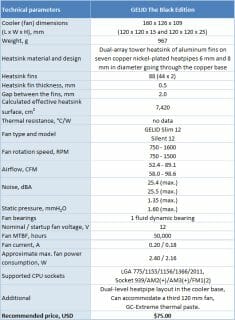
Packaging and Accessories
The cooler and its accessories are packed into a small box with a plastic carry handle:
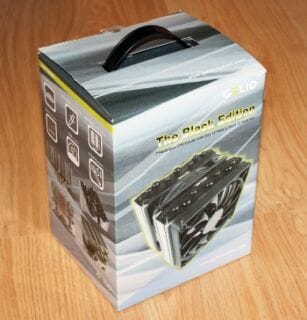
There’s a picture of the product on the front of the box. A detailed product description, including specifications and supported platforms, is printed on the other sides.
The cooler is fixed within pieces of polyethylene foam. Below them, there is a flat cardboard box with accessories:

They include a universal back-plate, fasteners for every supported platform, an installation guide, two pairs of wire brackets for fans, and high-efficiency GC-Extreme thermal grease.
The recommended price of the China-made cooler is $75. Its warranty period is 5 years.
Design and Functionality
The GELID Black Edition is a tower-design cooler with a dual-array heatsink and two fans:
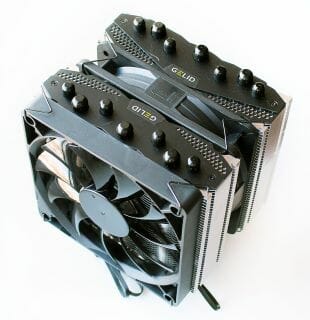
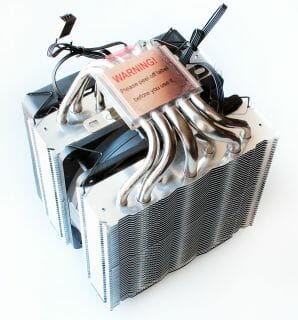
Its height is 160 mm. The width and depth are 126 and 109 mm, respectively. The weight of the cooler isn’t high at 967 grams.
The Black Edition name seems to refer to the two black fans and two metallic plates on the top fins of the heatsink. Yet the bulk of this cooler is silvery rather than black.
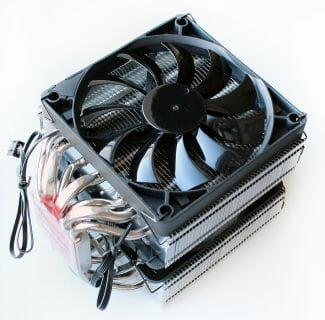
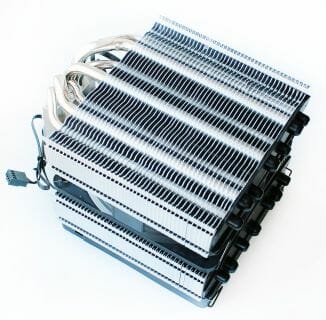
It represents a classic dual-array design where one fan is inserted in between the heatsink arrays and the other is fastened to the outer surface of one of them.
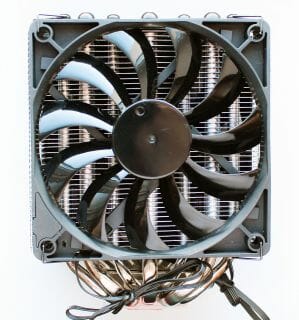
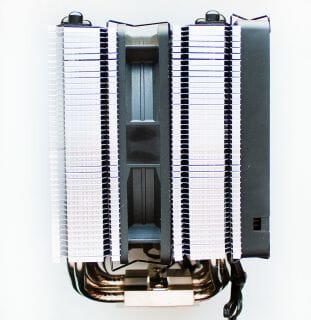
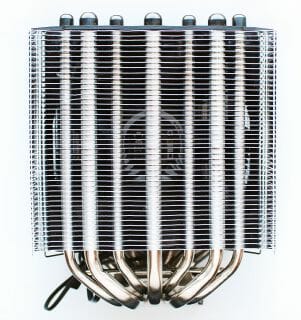
The heatsink sections being symmetrical, it is possible to install a third fan on them. You can find the required fasteners among the accessories.
If we take a look at the cooler from above, we can see that its heat pipes are not placed in a straight line. There’s a sticker on the cooler’s base which must be removed before its installation.
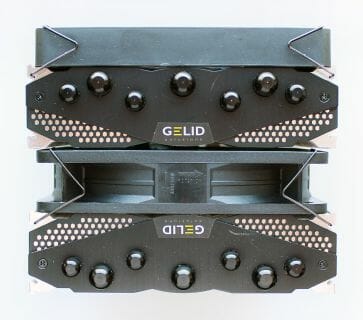

There’s nothing extraordinary about the Black Edition’s dual-array heatsink. Each array consists of 44 aluminum fins measuring 126×34.5 mm and 0.5 mm thick. The fins are press-fitted on the heat pipes with a spacing of 2.0 mm.
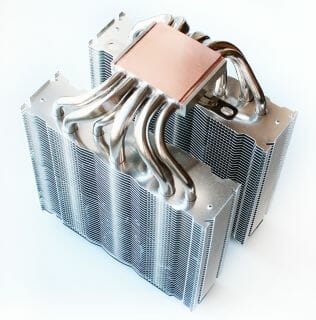
The heatsink has a total area of 7240 sq. cm, which is not too much for a super-cooler, especially for a dual-array cooler.
The heatsink fins have a wavy profile to optimize air flows.
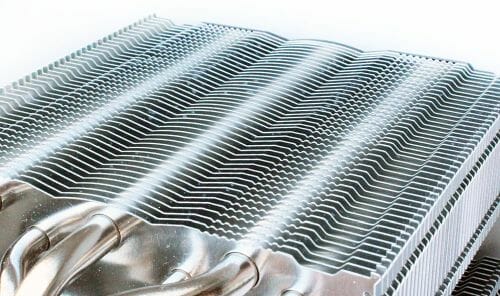
The heat pipes are neatly soldered to the cooler’s base.
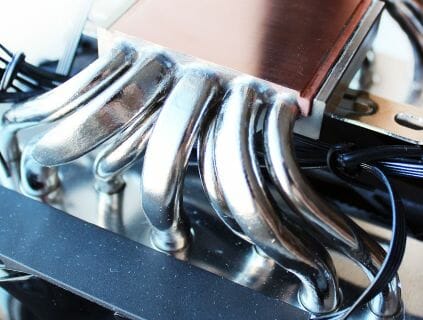
That’s where we can find the key feature of the Black Edition design. Let’s take a look at the thermal flow picture taken from the GELID website. It shows the distribution of heat among the pipes in the cooler’s base.
As you can see, the outermost pipes don’t do much work with the classic heat pipe arrangement. That’s why the heat pipes are arranged in the Black Edition’s base in an unconventional way. The three 8mm pipes in the middle do the bulk of work. They are aided by four ordinary 6mm pipes placed on their sides and above them. All of this should ensure more efficient heat transfer between the cooler’s base and the CPU’s heat-spreader. It must be noted that it’s not the first time we see this original solution. It was implemented in the GELID GX-7 we tested in 2011, for example.
The copper base is finished well enough. It is ideally smooth, although not polished to a mirror shine.
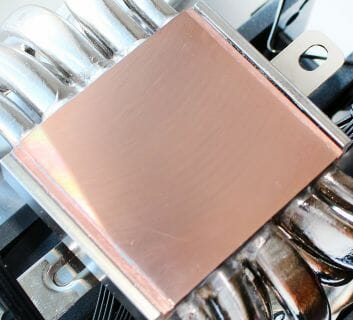
It is flat except for one corner but the thermal grease imprint on our LGA2011 processor was good:
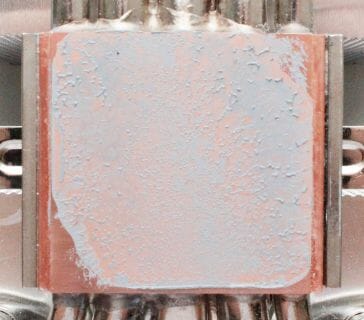
The GELID Black Edition is equipped with two 120mm fans that differ in thickness. The exterior fan Slim 12 is about 16 mm thick and has an 11-blade impeller.
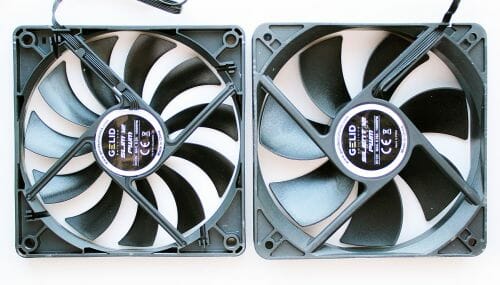
The Silent 12 fan, which is installed between the two heatsink arrays, has a standard thickness of 25 mm. Its impeller has 7 blades. Both fans are PWM-regulated using the same signal as both are powered via a single connector with a Y-shaped splitter. Their specs are very similar. The bottom speed is the same at 750 RPM whereas the top speed is 1500 for the classic fan and 1600 RPM for the slim external fan. The specified noise level is 25.4 and 25.5 dBA, respectively.
Both fans run on fluid dynamic bearings with a guaranteed service life of 50,000 hours (or about 5.7 years of continuous operation). Their model names and key electric specs can be read from the stickers on their motors:
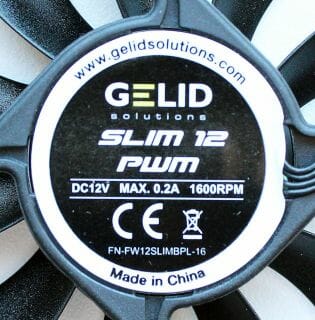
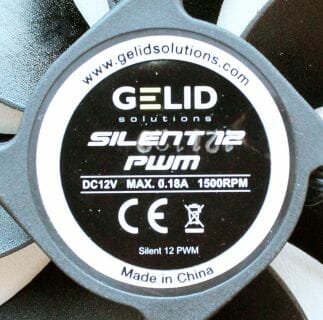
The peak power consumption of the fans is barely above 2 watts. According to our measurements, the startup voltage is 4 volts.
Compatibility and Installation
It is good that there are fewer CPU coolers limited to only one platform nowadays, and there are no such coolers at all in the top price segment the GELID Black Edition belongs to. Of course, the latter can be installed on any modern platform without any exceptions. The installation instructions can be downloaded from the official website. We’ll cover them quickly using our testbed with LGA2011 CPU.
The whole procedure takes four simple steps. First, you insert dual-sided threaded pins into the socket’s mounting holes.
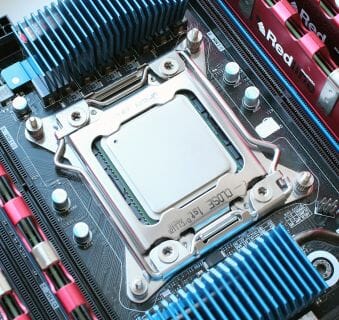
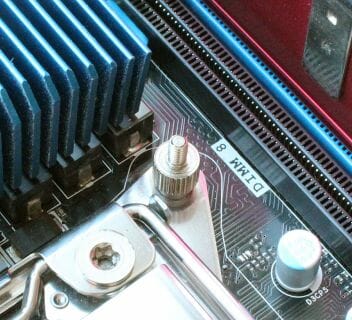
Then you secure two steel guides on them.
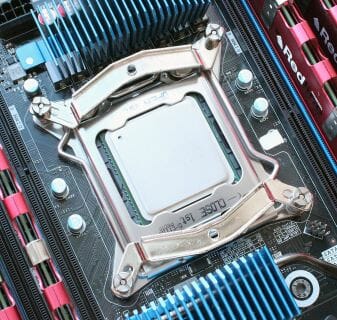
On the third step you mount the heatsink on the guides.
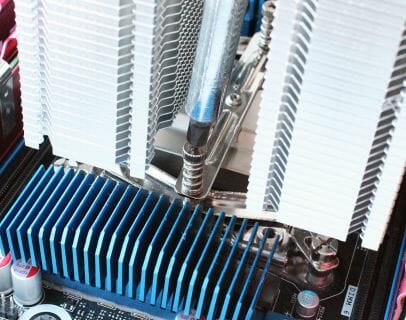
Don’t forget to apply some thermal grease on the CPU beforehand. Finally, you only have to attach fans with wire brackets to the heatsink. The fans are connected to the mainboard with a Y-shaped splitter. That’s all.
The distance between the heatsink’s bottom and the mainboard is 50 millimeters but the fans are somewhat lower, reducing that number by 5 to 7 millimeters.

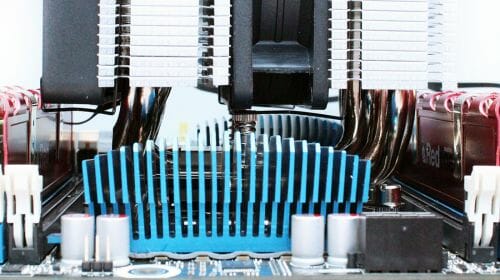
As you can see, the GELID Black Edition may conflict with memory modules with tall heatsinks installed in the nearest slots.
Here is how the new cooler looks inside our system case:
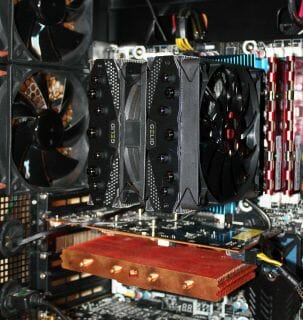
Testbed Configuration and Testing Methodology
We tested all coolers inside a closed system case with the following configuration:
- Mainboard: Intel Siler DX79SI (Intel X79 Express, LGA 2011, BIOS 0537 from 07/23/2012);
- CPU: Intel Core i7-3960X Extreme Edition, 3.3 GHz, 1.2 V, 6 x 256 KB L2, 15 MB L3 (Sandy Bridge-E, C1, 32 nm);
- Thermal interface: ARCTIC MX-4;
- Graphics card: AMD Radeon HD 7770 1 GB GDDR5 128 bit 1000/4500 MHz (with a passive cooper heatsink from Deep Cool V4000);
- System memory: DDR3 4 x 4GB Mushkin Redline (Spec: 2133 MHz / 9-11-10-28 / 1.65 V);
- System drive: Crucial m4 256 GB SSD (SATA-III, CT256M4SSD2, BIOS v0009);
- Drive for programs and games: Western Digital VelociRaptor (300GB, SATA-II, 10000 RPM, 16MB cache, NCQ) inside Scythe Quiet Drive 3.5” HDD silencer and cooler;
- Backup drive: Samsung Ecogreen F4 HD204UI (SATA-II, 2 TB, 5400 RPM, 32 MB, NCQ);
- System case: Antec Twelve Hundred (front panel: three Noiseblocker NB-Multiframe S-Series MF12-S2 fans at 1020 RPM; back panel: two Noiseblocker NB-BlackSilent PRO PL-1 fans at 1020 RPM; top panel: standard 200 mm fan at 400 RPM);
- Control and monitoring panel: Zalman ZM-MFC3;
- Power supply: Seasonic SS-1000XP Active PFC F3 1000 W (with a default 120 mm fan).
For the today’s tests we overclocked our six-core processor with the clock generator frequency set at 125 MHz, the multiplier at 34x and “Load-Line Calibration” enabled to 4.375 GHz. The nominal processor Vcore was increased to 1.385 V in the mainboard BIOS. Turbo Boost was disabled during this test session, and Hyper-Threading technology was enabled to increase the heat dissipation. The memory voltage was at 1.65 V and its frequency was 2000 MHz with 9-11-10-28 timings. All other parameters available in the mainboard BIOS and related to CPU or memory overclocking remained unchanged.
All tests were performed under Windows 7 Ultimate x64 SP1 operating system. We used the following software during our test session:
- LinX AVX Edition version 0.6.4 – to load the processor (memory – 4500 MB, Problem Size – 24234, two 11-minute cycles);
- Real Temp GT version 3.70 – to monitor the processor core temperatures;
- Intel Extreme Tuning Utility version 3.1.201.5 – for monitoring and visual control of all system parameters during overclocking.
So, the complete screenshot during the test session looks as follows:
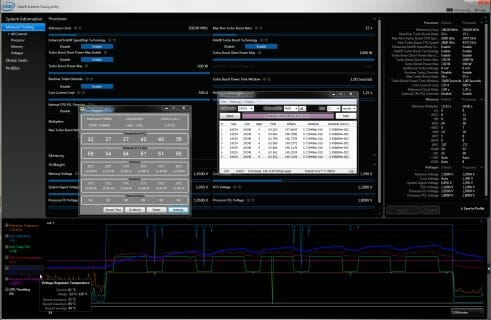
The CPU was loaded with two consecutive LinX AVX test runs with the settings as indicated above. The stabilization period for the CPU temperature between the two test cycles was about 8-10 minutes. We took the maximum temperature of the hottest CPU core for the results charts. Moreover, we will also provide a table with the temperature readings for all cores including their average values. The ambient temperature was checked next to the system case with an electronic thermometer with 0.1 °C precision that allows hourly monitoring of the temperature changes over the past 6 hours. The room temperature during our test session varied between 24.0-24.2°C.
The noise level of each cooler was measured between 1:00 and 3:00 AM in a closed room about 20 m2 big using CENTER-321 electronic noise meter. The noise level for each cooler was tested outside the system case when the only noise sources in the lab were the cooler and its fan. The noise meter was installed on a tripod and was always at a 150 mm distance from the cooler fan rotor. The tested cooling systems were placed at the edge of the desk on a sheet of polyurethane foam. The lowest noise reading our noise meter device can register is 29.8 dBA and the subjectively comfortable noise level in these testing conditions was around 36 dBA (do not mix it up with low noise level). The fan(s) rotation speed was adjusted in the entire supported range using our in-house controller by changing the voltage with 0.5 V increment.
Taking into account the MSRP of the GELID The Black Edition cooler set at $75.00, we decided not to overcomplicate things and simply compared it against the best air-cooler available today – Phanteks PH-TC14PE (MSRP $75.00), which two default 140 mm Phanteks PH-F140 fans were replaced with the quiet Corsair AF140 fans:
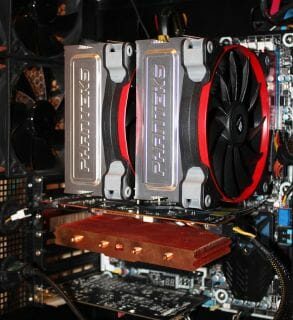
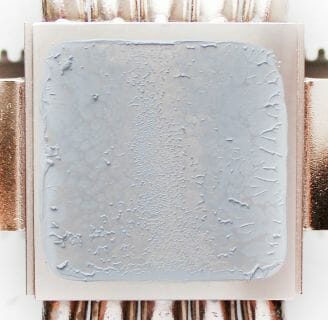
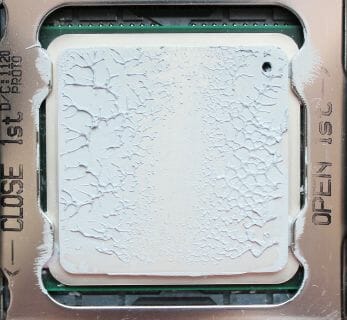
As we have already mentioned previously, this modification didn’t affect the cooling efficiency, as we have already pointed out in our previous reviews, but it significantly reduced the level of generated noise. Nevertheless, we are going to also include the Phanteks cooler results in its default configuration. I would also like to add, that the rotation speed of all fans was controlled using our in-house controller with ±10 RPM precision and 200 RPM increments.
Performance
Cooling Efficiency
You can see the results of our tests in this table as well as in the following diagram:

Rotating its fans at higher speed, the GELID Black Edition can deliver the same performance as the Phanteks PH-TC14P? at 950 RPM. However, if the speed is reduced by 200 RPM, the Black Edition lets the peak CPU temperature rise by 3°C, losing to the Phanteks. The lower the speed of the two 120mm fans of the GELID cooler, the higher the CPU temperature during our test. As a result, the Black Edition is as much as 9°C worse than the Phanteks PH-TC14P? at 800 RPM. Considering that they come at the same recommended price, the GELID can hardly be viewed as a worthy competitor.
You can compare the new cooler’s performance with products we tested previously in the following table and diagram. Each cooler was tested in its default configuration in the quiet mode and at the maximum speed of the fan(s) with the CPU overclocked to 4.375 MHz at a voltage of 1.385 volts.
We can see that the GELID Black Edition looks good at the maximum speed of its two default fans but its performance is far from efficient in the quiet mode at 800 RPM:
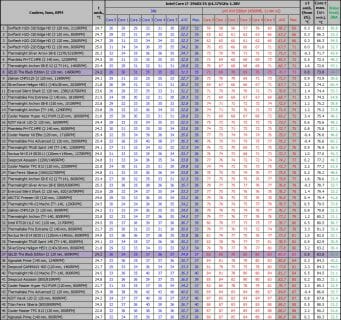
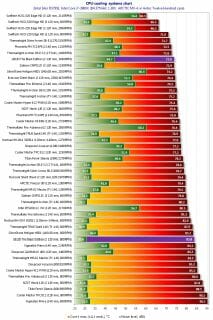
Our attempts to overclock the CPU with the GELID Black Edition further were unsuccessful. The test program would abort with an error even at 4500 MHz and 1.440 volts.
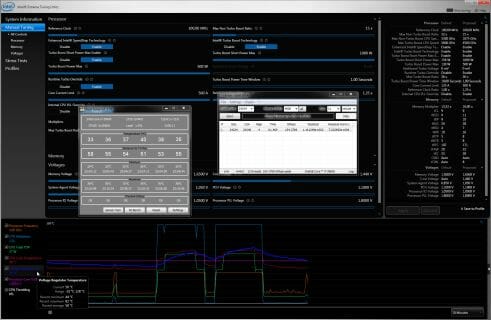
Thus, the GELID Black Edition takes a leading position in the bottom group of coolers which managed to reach the CPU clock rate of 4.375 GHz.
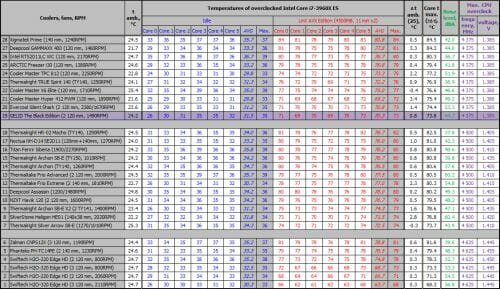
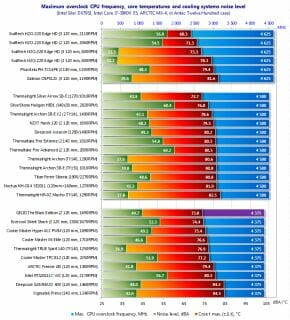
The result is good in terms of noise as well. The GELID isn’t the loudest cooler in that group.
Noise Level
We measured the noise level of our coolers throughout the entire speed range of their fans. Here are the results:

The GELID Black Edition enjoys a huge advantage over its opponent in terms of noisiness. Even if we disregard the noisy default fans of the Phanteks, the latter is louder than the GELID with two quiet 140mm Corsair fans, too. The Phanteks remains comfortable only up to 700 RPM with the default fans and up to 960 RPM with the Corsair fans, but the two GELID fans are comfortable enough all the way up to 1140 RPM. Comparing the two fans the GELID Black Edition comes with, the outer 16mm fan is noisier although the standard 25mm fan installed between the two heatsink arrays might be expected to produce more noise. The Black Edition becomes quiet if its fans work at 980 RPM or lower, which is a good result, too. We didn’t hear any vibrations, rattle or anything from the fans of the GELID cooler during our tests.
Conclusion
The GELID Black Edition is a universal cooler which can be easily installed on any platform using reliable fasteners. It comes with high-quality fans that make it comfortable in terms of noisiness in a quiet computer at speeds up to 1140 RPM. The buyer also receives high-efficiency GC-Extreme thermal grease among the accessories.
However, the key parameter of any cooler – its cooling performance – isn’t impeccable. The Black Edition may compete with the best super-cooler at the maximum speed of its fans only. When the speed is lowered to a comfortable level, its performance degrades, making it uncompetitive among same-class products. The GELID Black Edition also didn’t do well in our overclockability test when we tried to reach the maximum frequency of our CPU. We had expected more from it in this respect.
That’s why we guess this product may be priced a little too high. For $75 you can find coolers that are more efficient than and as quiet as the Black Edition. The choice is yours, though.